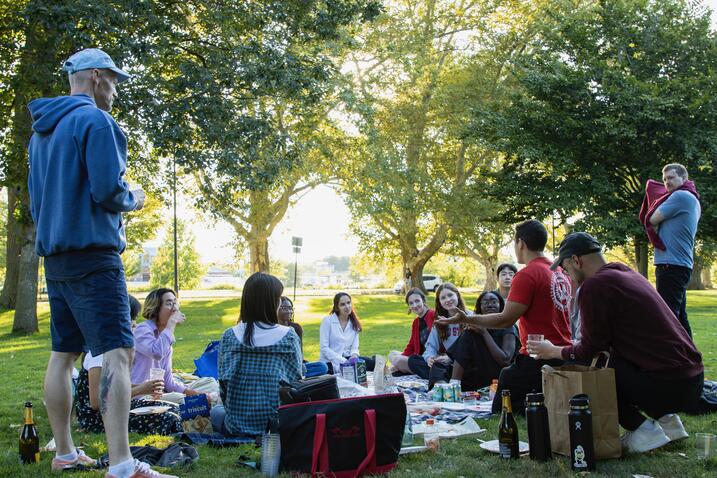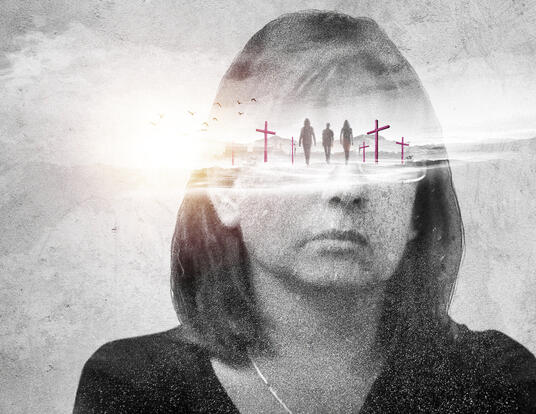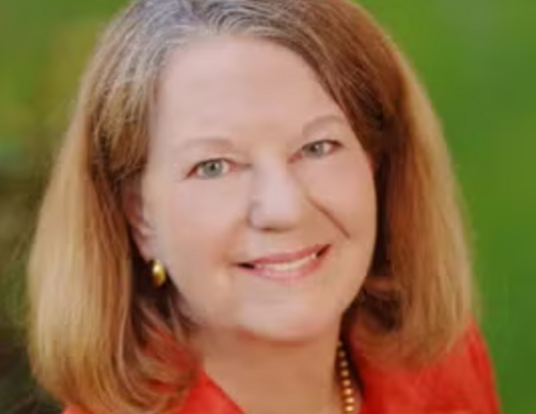Surviving San Quentin
Johnny Smith studies the impact that higher education can have on formerly incarcerated people like him, so that others can hold onto their freedom and lead full, productive lives
The day a race riot nearly broke out was the scariest in the eight months Johnny Smith spent incarcerated at the California Department of Corrections and Rehabilitation’s San Quentin State Prison, a place he says was “driven by violence.” During a rare opportunity for outside recreation, two men—one Black and one Hispanic—started to fight. Immediately, the others—nearly 300 in all—sorted into groups by race and prepared for a melee.
“The prison has gunners with actual rifles,” Smith remembers. “They started shouting commands for everybody to get down on the ground. Some people obeyed. Some people were still scared that the violence was going to happen, so they were in a crouch position, ready to defend themselves if they had to. A whole crisis response team and a specialized police unit came in with riot gear and tactically extracted one race at a time. That’s how that was diffused. But we were a hair trigger away from massive violence.”
The path from medium security prison—as well as opioid addiction and family trauma—to a PhD program at the Harvard Kenneth C. Griffin Graduate School of Arts and Sciences is narrow and has few travelers. Somehow, Johnny Smith found his way to it and through it. Today, in the University’s Department of Sociology, he studies the impact that higher education can have on formerly incarcerated people like him, so that others can hold onto their freedom, and lead full, productive lives.
Dysfunction, Dependence, and Detention
Smith grew up in Southern California, one of four children. His parents separated before he could remember, and his father was inconsistently present during his childhood. His mother worked multiple jobs, leaving him and his younger sister in the care of his two older siblings, particularly his brother, who was swept up in gang activity and substance abuse. Life was uncertain and unstable. “We were evicted a lot,” he says. “I couldn’t tell you how many different places we lived. I don’t remember staying in one school for an entire year.”
With parents and siblings who barely got their high school diplomas or equivalent, education “wasn’t of value” in Smith’s home. His future seemed to be to follow in the footsteps of his brother, a leader in his gang, whom Smith both idolized and feared. He evaded the gravitational pull of gang life, but, sadly, not the substance use that accompanied it. Smith began experimenting with cannabis when he was 11. Some years later, a friend offered him an opioid at work. Smith took it, felt great, and was more productive. So, he continued using the drugs. When a close family member got a job at a pharmacy, they enabled his habit, bringing him and his friend expired opioids from work.
“We took it recreationally until it ran out, and they would bring more,” he says. “It went on long enough for me to develop a dependence.”
That dependence gradually led Smith to sell everything he owned to support his habit. When he had nothing left—and support from family and friends was no longer an option because he had betrayed their trust—he turned to crime. After he was convicted of residential burglary, he was assigned to a prison alternative program he describes as “behavior-modification, extreme attack-therapy.” Smith didn’t complete the program and so was sent to prison, but it did arrest his substance use for the first time in years. It also introduced him to a value system that enabled him to survive the eight months he spent at the notoriously violent San Quentin State Prison.
Being at San Quentin—being responsible for myself and knowing nobody’s coming to rescue me—I realized I didn’t belong there.
–Johnny Smith
“I continued my sobriety, so I had a clear perspective for the first time since I’d started using substances when I was 11,” he says. “And I had this new value system: honesty, integrity, social responsibility, and accountability. I did everything I could to protect it, even in a hostile environment like prison.” Despite nearly being swept up in a race riot, Smith made it through San Quentin and was able to serve the last eight months of his sentence in a low-security facility. Without the constant threat of violence, he had time to reflect.
“Being at San Quentin—being responsible for myself and knowing nobody’s coming to rescue me—I realized I didn’t belong there,” he says. “And so I really started to evaluate myself and my life choices. I took an inventory of the things I wanted to change. On that list was to get my GED (certificate of General Educational Development). That’s as far as my mind could see in terms of education. That was the pinnacle.”
Underground Scholar
Smith did get his GED while completing a post-prison residential program. Despite dropping out of school in the eighth grade, he had been an observant, analytical child. Reading, which had been a struggle for him, started to be a pleasure while he was incarcerated. He began writing creatively. Impressed by an essay of Smith’s, a counselor suggested he enroll in community college, which he did in 2015 at age 29 after his release from prison, earning perfect marks.
“It only took a few classes to realize I was in the right place,” he says. “I submitted some writing assignments and was affirmed by my teacher in a way that brought me to tears.”
That teacher, Santa Rosa Junior College English Professor Jessica Taylor, says that her former student stood out immediately. “He sat in the front row, did all of the reading, listened intently to his peers, took seriously the class and small group discussions, visited me in office hours, and infused the classroom with a positive spirit,” she says. It was the student’s first essay, however—"a personal manifesto” about identity—that demonstrated his capacity for intellectual leadership.
“I was floored,” Taylor says. “His voice was so strong on the page, with all the elements of what makes writing good: courage; honest, unromantic details; self-awareness; attention to detail. He hadn't just dashed something off; he'd crafted something that moved me. When he landed in my Critical Thinking class a few semesters later, his writing had only gotten better. By then, he'd emerged as an inspirational leader among his peers.”
Taylor was so impressed that she suggested Smith apply to the University of California’s flagship Berkeley campus as an undergraduate. “I knew that Johnny had the motivation, resilience, and brilliance to aim high, and I also knew that the only thing standing in his way was self-doubt. He just needed the validation. That was an easy thing to give to someone who had worked so hard and come so far. I had a feeling that he'd feel at home at a place like Berkeley, with so many other high achievers.”
“I was floored [by Smith’s first essay]. His voice was so strong on the page . . . He hadn't just dashed something off; he'd crafted something that moved me.
–Santa Rosa Junior College Professor Jessica Taylor
Smith was delivering pizzas on the day the email from Berkeley appeared in his inbox. “Digital confetti popped on the screen, when I opened it. I didn’t really have to read much more. I was outside by myself, and I just started crying. [Professor Taylor] was the first person I told.”
The shimmering campus of the country’s leading public research university was a very different environment from the one Smith had grown up in—and the polar opposite of prison. Berkeley’s innovative Underground Scholars program for formerly incarcerated students enabled him to connect with others who shared at least part of his experience. Navigating Cal, a course for new students from traditionally marginalized groups, also set him up for success.
Still, there were plenty of adjustments to make. Smith says he never really suffered from impostor syndrome because, at some level, he couldn’t quite process that he was really at Berkeley. “That campus, walking around . . . it was just surreal,” he says. “For quite some time, I couldn’t believe I was even there. That was something that took some getting used to.”
In some ways, there were also advantages to being a 33-year-old college student. Smith knew what he wanted to study—sociology—and focused squarely on schoolwork, again earning perfect marks. Accepted to Berkeley’s prestigious Haas Scholars Program, he conducted advanced research on the carceral system, specifically, the role of probation and parole officers.
“There’s this occupational duality,” he says. “On the one hand, they have this law-enforcement role, and on the other, they have a social-worker role. There’s a tension there. My project was to explore the strategies that they use to negotiate that tension.”

Employment or Education?
By the time he graduated from Berkeley, Smith had co-authored a study of the impact of Pell Grants and financial aid on formerly incarcerated individuals. The research also explored model programs like the Underground Scholars, tracing outcomes and the barriers faced by those with a criminal record. He had also set his sights on a PhD, winning acceptance from Berkeley and Harvard—the country’s top two sociology programs. He chose Harvard to work with Professor Christopher Muller, PhD ’14, who had taught at Berkeley and was conducting groundbreaking research on incarceration in the US.
Muller says that Smith’s firsthand experience with the transformative power of higher education both drives and grounds the PhD student’s work. “He wants to know how the experience of people on probation or parole might change if they were incentivized to pursue education,” he says. “At a time when the gap in the incarceration rates of people with and without a college education is widening, his work couldn't be timelier.”
Today, that work continues to explore the intersection of post-release community supervision—probation and parole—and education. “In most jurisdictions, parolees are required to seek and maintain employment as a condition of their release,” Smith says. “That’s an important and pragmatic requirement, but it overlooks the structural barriers to stable work and ignores the transformative potential of education. Research shows that achievement in higher education is strongly correlated with reduced recidivism. So, my idea is to use both quantitative and qualitative methods to analyze the structural, ideological, and institutional reasons why employment is prioritized over education.”
[Smith] wants to know how the experience of people on probation or parole might change if they were incentivized to pursue it. At a time when the gap in the incarceration rates of people with and without a college education is widening, his work couldn't be timelier.
–Harvard Sociology Professor Christopher Muller, PhD ’14
Not surprisingly, Smith draws on his lived experience for insight and inspiration, and also on the sense of social responsibility to which he was introduced just before those terrifying months at San Quentin. His hope is that his research can help others to find their way from desperation to lives of learning and fulfillment—particularly those whose path from incarceration and addiction to education may be more meandering than his own.
“When I was released and started at community college for the first three years, I was also on parole supervision,” he reflects. “There was a tension between how I excelled in academia, and how heavily I was scrutinized, as if my parole officer was trying to catch me being deviant. This disconnect made me want to scrutinize the probation experience. Because if I was a ‘star client’ on probation, doing everything I could to demonstrate I’d transformed my life, I can’t imagine how it’s going for everybody else.”
Banner photo by Amber Smith
Get the Latest Updates
Join Our Newsletter
Subscribe to Colloquy Podcast
Simplecast





